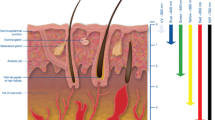Abstract
Device-tissue interface geometry influences both the intensity of detected fluorescence and the extent of tissue sampled. Previous modelling studies have often investigated fluorescent light propagation using generalised tissue and illumination-collection geometries. However, the implementation of approaches that incorporate a greater degree of realism may provide more accurate estimates of light propagation. In this study, Monte Carlo modelling was performed to predict how illumination-collection parameters affect signal detection in multilayer tissue. Using the geometry and optical properties of normal and atherosclerotic aortas, results for realistic probe designs and a semi-infinite source-detection scheme were generated and compared. As illumination-collection parameters, including single-fibre probe diameter and fibre separation distance in multifibre probes, were varied, the signal origin deviated significantly from that predicted using the semi-infinite geometry. The semi-infinite case under-predicted the fraction of fluorescence originating from the superficial layer by up to 23% for a 0.2 mm diameter single-fibre probe and over-predicted by 10% for a multifibre probe. These results demonstrate the importance of specifying realistic illumination-collection parameters in theoretical studies and indicate that targeting of specific tissue regions may be achievable through customisation of the illumination-collection interface. The device- and tissue-specific approach presented has the potential to facilitate the optimisation of minimally invasive optical systems for a wide variety of applications.
Similar content being viewed by others
References
Arakawa, K., Isoda, K., Ito, T., Nakajima, K., Shibuya, T., andOhsuzu, F. (2002): ‘Fluorescence analysis of biochemical constituents identifies atherosclerotic plaque with a thin fibrous cap’,Arterioscler. Thromb. Vasc. Biol.,22, pp. 1002–1007
Avrillier, S., Tinet, E., Ettori, D., Tualle, J. M., andGelebart, B. (1998): ‘Influence of the emission-reception geometry in laser-induced fluorescence spectra from turbid media’,Appl. Opt.,37, pp. 2781–2787
DaCosta, R. S., Lilge, L. D., Kost, J., Cirroco, M., Hassaram, S., Marcon, N., andWilson, B. C. (1997). ‘Confocal fluorescence microscopy, microspectrofluorimetry, and modeling studies of laser-induced fluorescence endoscopy (LIFE) of human colon tissue’,Proc. SPIE,2975, pp. 98–107
Drezek, R., Sokolov, K., Utzinger, U., Boiko, I., Malpica, A., Follen, M., andRichards-Kortum, R. (2001): ‘Understanding the contributions of NADH and collagen to cervical tissue fluorescence spectra: modeling, measurements, and implications’,J. Biomed. Opt.,6, pp. 385–396
Gmitro, A. F., Cutruzzola, F. W., Stetz, M. L., andDeckelbaum, L. I. (1988): ‘Measurement depth of laser-induced fluorescence with application to laser angioplasty’,Appl. Opt.,27, pp. 1844–1849
Jacques, S. L., andWang, L. (1995): ‘Monte Carlo modeling of light transport in tissues’, inWelch, A. J., andvan Gemert, A. J. (Eds): ‘Optical-thermal response of laser-irradiated tissue’ (Plenum Press, New York, 1995)
Keijzer, M., Richards-Kortum, R. R., Jacques, S. L., andFeld, M. S. (1989): ‘Fluorescence spectroscopy of turbid media: auto-fluorescence of the human aorta’,Appl. Opt.,28, pp. 4286–4292
Pfefer, T. J., Schomacker, K. T., Ediger, M. N., andNishioka, N. S. (2001): ‘Light propagation in tissue during fluorescence spectroscopy with single-fiber probes’,IEEE J. Sel. Top. Quant. Elect.,7, pp. 1004–1012
Pfefer, T. J., Schomacker, K. T., Ediger, M. N., andNishioka, N. S. (2002): ‘Multiple-fiber probe design for fluorescence spectroscopy in tissue’,Appl. Opt.,41, pp. 4712–4721
Pfefer, T. J., Matchette, L. S., Ross, A. M., andEdiger, M. N. (2003): ‘Selective detection of fluorophore layers in turbid media: the role of fiberoptic probe design’,Opt. Lett.,28, pp. 120–122
Qu, J., MacAulay, C., Lam, S., andPalcic, B. (1995): ‘Laser-induced fluorescence spectroscopy at endoscopy: tissue optics, Monte Carlo modeling andin vivo measurements”,Opt. Eng.,34, pp. 3334–3343
Quan, L., andRamanujam, N. (2002): ‘Relationship between depth of a target in a turbid medium and fluorescence measured by a variable-aperture method’,Opt. Lett.,27, pp. 104–106
Richards-Kortum, R., Mehta, A., Hayes, G., Cothren, R., Kolubayev, T., Kittrell, C., Ratliff, N. B., Kramer, J. R., andFeld, M. S. (1989): ‘Spectral diagnosis of atherosclerosis using an optical fiber laser catheter’,Am. Heart J.,118, pp. 381–391
Richards-Kortum, R. (1995). ‘Fluorescence spectroscopy of turbid media’, inWelch, A. J., andvan Gemert, M. J. C. (Eds): ‘Optical-thermal response of laser-irradiated tissue’ (Plenum Press, 1995)
Vishwanath, K., Pogue, B. W., andMycek, M. A. (2002): ‘Quantitative fluorescence lifetime spectroscopy in turbid media: comparison of theoretical, experimental and computational methods’,Phys. Med. Biol.,47, pp. 3387–3405
Wagnieres, G. A., Star, W. M., andWilson, B. C. (1998): ‘In vivo fluorescence spectroscopy and imaging for oncological applications’,Photochem. Photobiol.,68, pp. 603–632
Wang, L., Jacques, S. L., andZheng, L. (1995): ‘MCML — Monte Carlo modeling of light transport in multi-layered tissues’,Comput. Methods Programs Biomed.,47, pp. 131–146
Welch, A. J., Gardner, C., Richards-Kortum, R., Chan, E., Criswell, G., Pfefer, J., andWarren, S. (1997): ‘Propagation of fluorescent light’,Lasers Surg. Med.,21, pp. 166–178
Zhu, C., Liu, Q., andRamanujam, N. (2003). ‘Effect of fiber optic probe geometry on depth-resolved fluorescence measurements from epithelial tissues: a Monte Carlo simulation’,J. Biomed. Opt.,8, pp. 237–247
Zonios, G. I., Cothren, R. M., Arendt, J. T., Wu, J., Van Dam, J., Crawford, J. M., Manoharan, R., andFeld, M. S. (1996): ‘Morphological model of human colon tissue fluorescence’,IEEE Trans. Biomed. Eng.,43, pp. 113–122
Author information
Authors and Affiliations
Corresponding author
Rights and permissions
About this article
Cite this article
Pfefer, T.J., Matchette, L.S. & Drezek, R. Influence of illumination-collection geometry on fluorescence spectroscopy in multilayer tissue. Med. Biol. Eng. Comput. 42, 669–673 (2004). https://doi.org/10.1007/BF02347549
Received:
Accepted:
Issue Date:
DOI: https://doi.org/10.1007/BF02347549




